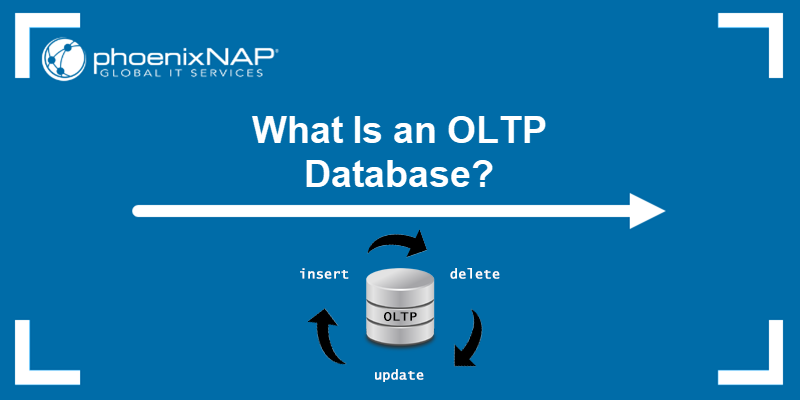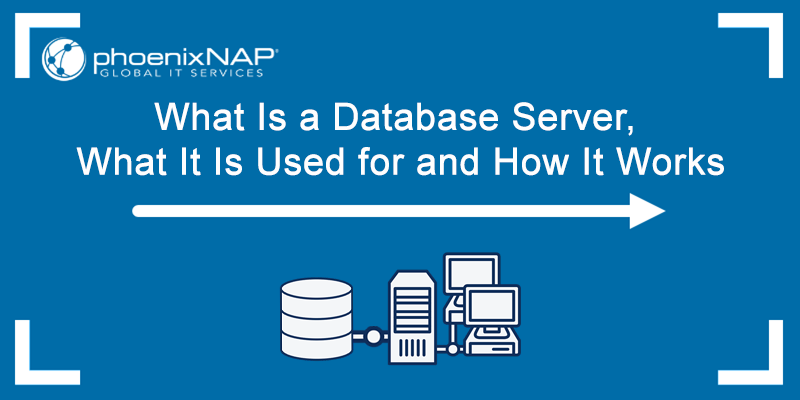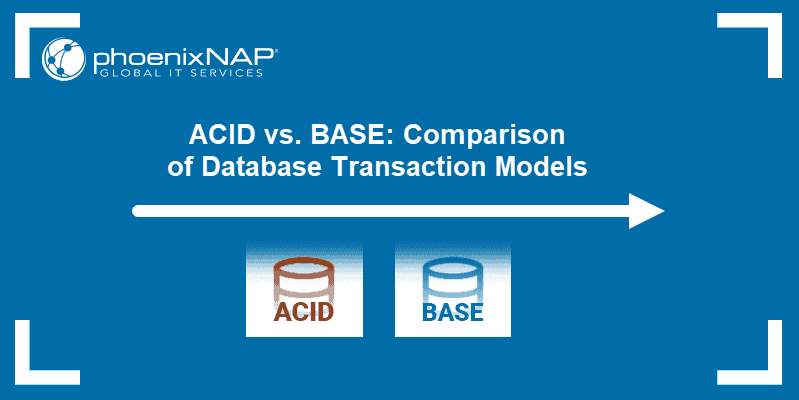Introduction
OLTP and OLAP are online processing systems that help turn data into information. OLTP deals with data transactions, while OLAP deals with data analytics. Although there are differences, the main idea is to use the two processes to form a stable data warehouse architecture.
This article explains the main differences between OLTP and OLAP systems and how to utilize the two when processing data.
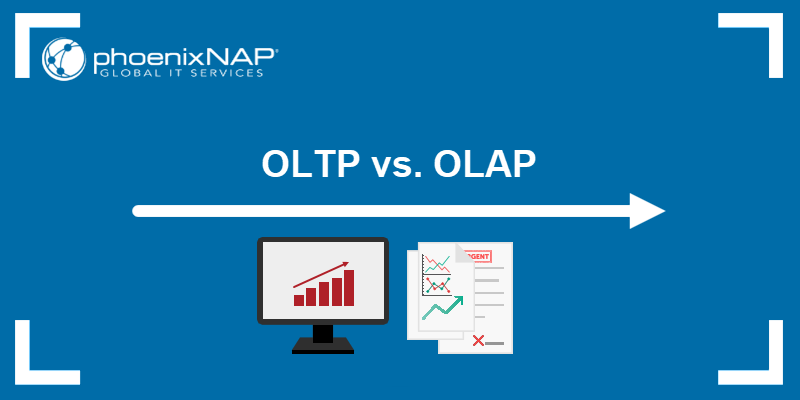
OLTP vs. OLAP: Definitions
The first step in comprehending the main difference between the OLTP and OLAP systems is to know how to define each. The definitions help describe the main features of each processing system as well.
OLTP (Online Transaction Processing)
OLTP is short for Online Transaction Processing. The system provides data to a dedicated storage server directly from the source. The main characteristics of OLTP are:
- Frequent query processing. Inserting, updating, and deleting data are everyday tasks in an OLTP database.
- Fast transactions. The system constantly deals with short and frequent transactions to stay updated with the most current information.
- Data integrity. In case of any failures, rollback segments are crucial to keeping data integrity as well as consistency. The stability of information flow is possible due to database normalization up to at least the third normal form (3NF).
Overall, the OLTP system design provides immediate response to simple business processes and user requests through a relational database.
OLAP (Online Analytical Processing)
OLAP is short for Online Analytical Processing. The method takes data collected by an OLTP system and prepares it for analytical purposes. The main characteristics of an OLAP system are:
- Smaller query volume. Selecting multidimensional data is a common task in an OLAP database.
- Complex transactions. The system handles historical data and tackles analytical tasks in large volumes. The emphasis is on executing complex queries quickly for decision-making processes.
- Query speed. Database denormalization techniques help improve the query speed with OLAP databases. Although information retrieval is fast, data inconsistencies are present.
The OLAP system provides quick responses to complex and multidimensional workloads typically needed in a data warehouse.
OLTP vs. OLAP: Comparison
OLTP and OLAP are different in terms of functionality. The OLAP database systems became more popular with the rise of big data and analytics. The two systems work best when connected through the ETL (extract, transform, load) layer.
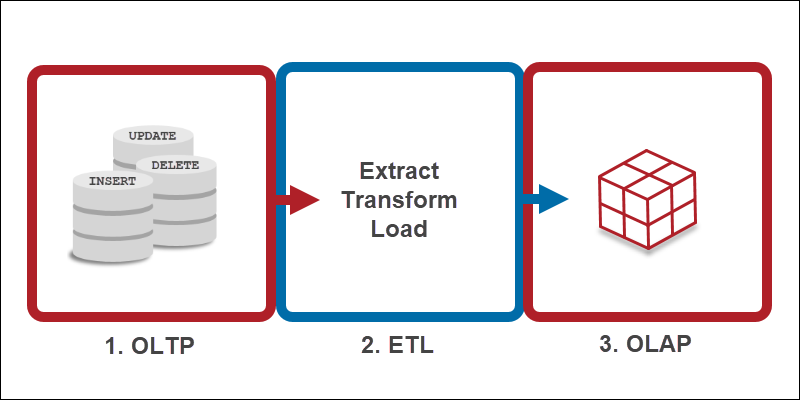
Note: Spark streaming is an excellent example of a utilized ETL layer. For a practical example of data ingestion, check out our Spark streaming guide for beginners.
The table below outlines the main differences between the two processing techniques:
| OLTP | OLAP | |
|---|---|---|
| Stands for | Online Transactional Processing | Online Analytical Processing |
| Functionality | Modifies and writes data often | Queries data, rarely writes |
| Main Feature | Low latency | High throughput |
| Queries | INSERT, UPDATE, DELETE | SELECT |
| Query Complexity | Simple and standardized | Complex and specialized |
| Normalization | Normalized | Unnormalized or denormalized |
| Database Architecture | Traditional | Data warehouse |
| Design | Industry oriented | Subject oriented |
| Integrity | Frequently modified and maintained | Not often changed or maintained |
| Data Redundancy | Low | High |
| Availability | High availability | Low availability |
| Storage Size | Small if data is archived | Large database servers |
| Number of Users | Thousands | Hundreds |
| Productivity | Short term and daily goals | Long term goals |
| Performance metric | Transaction throughput | Query throughput |
| Response time | Milliseconds | Seconds to minutes |
| Used for | Basic business tasks in high volumes | Planning, analytical tasks, decision making |
| Used by | Clerks, administrators, and data critical sectors | Data scientists, marketing, and decision-making sectors |
| Audience | Market-oriented information | Customer-oriented information |
OLTP Use Cases
OLTP systems are in nearly every consumer-facing system. Some of the everyday use cases for transactional processing are:
- ATM and Online Banking. Daily financial withdrawals and payments represent simple everyday transactions supported by OLTP systems.
- Payment Processing. Both online and in-store payments are transactional processes, whether it is a debit or credit card.
- Online Booking. Any reservation, ticketing, and booking system require OLTP methods and specifications.
- Recordkeeping. Whether the records are medical, educational, inventory control, or a customer service ticketing system, record keeping is a process that needs fast-paced management.
OLAP Use Cases
An OLAP system is found in every branch of business that benefits from data analysis. Frequently, analytical processing finds use in:
- Trend Analysis. OLAP systems assist in decision-making with statistical analysis of trends in many sectors, from healthcare to retail.
- Customer Behavior. Different dimensions of customer information, such as geographic or demographic data, helps determine customer behavior for ecommerce industries.
- Agriculture. A recent and most exciting application is in the agriculture sector. Massive amounts of information processed with edge computing help generate reports for rural businesses.
Advantages and Disadvantages of OLTP
OLTP is system-oriented towards a high number of simple transactions with immediate responses. The transactional data processing technique has certain benefits and drawbacks.
Advantages
Some advantages of using OLTP are:
- Concurrency. A high volume of transactions from numerous users requires a high level of concurrency.
- Atomicity. Either a whole transaction occurs, or nothing happens. The system is immune to partial updates and information loss.
- Speed. All the occurring transactions are simple. Constant updates require sub-second response times.
Disadvantages
The disadvantages of OLTP include:
- Downtime. Any downtime causes a bottleneck in the high volume of requests. The systems must use high availability solutions.
- Security. When dealing with any data regarding people, safety is of the utmost priority. OLTP requires high levels of security, which is hard to manage with the massive number of transactions.
- Request volume. The sheer number of requests is overwhelming. The amount of raw data requires a team of data experts to find actionable information.
Advantages and Disadvantages of OLAP
OLAP focuses on data discovery processes and multidimensionality. The analytical approach to database analysis comes with advantages as well as disadvantages.
Advantages
The overall advantages to using an OLAP system are:
- Comprehensive. Complex queries on multidimensional data provide a broad overview of information from various databases.
- Decision-making support. With the help of star and snowflake schemas, the OLAP system provides the flexibility needed for decision support systems.
- Flat learning curve. The end-users of OLAP-based systems need little to no technical training.
Disadvantages
Some of the weaknesses in OLAP systems are:
- Data redundancy. High levels of data redundancy are present due to denormalization.
- Storage scalability. The system requires a scalable storage solution as the information system grows.
- Computation capabilities. Because non-technical professionals use OLAP systems, the computation resources lack power. Often, third-party software and tools are needed to perform complex computations.
Conclusion
The OLTP and OLAP processing systems both deal with information in their domain. While OLTP is helpful for business processes, OLAP comes in handy when analyzing trends and critical information for the growth of a business.
Next, check out our article on cloud databases to see which modern solution works best for your database system.
